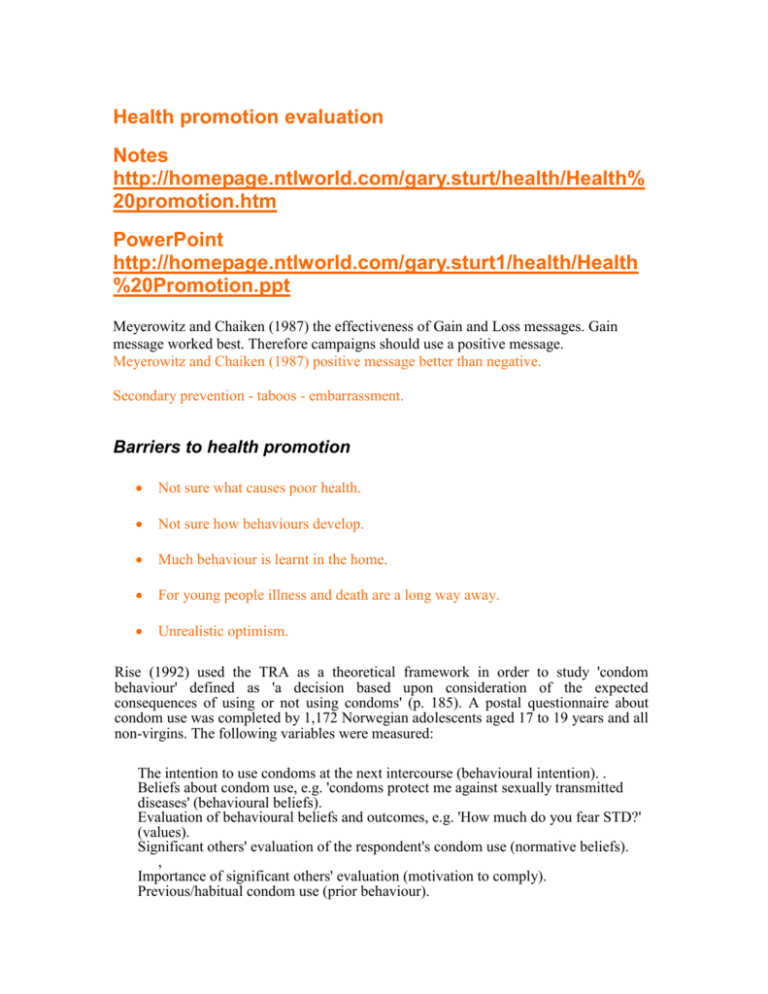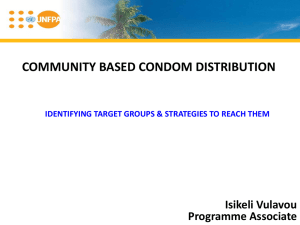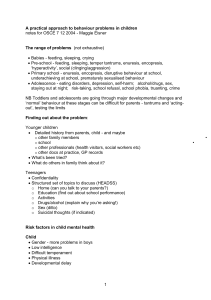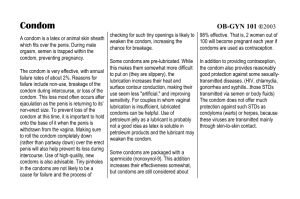Health promotion evaluation
advertisement

Health promotion evaluation Notes http://homepage.ntlworld.com/gary.sturt/health/Health% 20promotion.htm PowerPoint http://homepage.ntlworld.com/gary.sturt1/health/Health %20Promotion.ppt Meyerowitz and Chaiken (1987) the effectiveness of Gain and Loss messages. Gain message worked best. Therefore campaigns should use a positive message. Meyerowitz and Chaiken (1987) positive message better than negative. Secondary prevention - taboos - embarrassment. Barriers to health promotion Not sure what causes poor health. Not sure how behaviours develop. Much behaviour is learnt in the home. For young people illness and death are a long way away. Unrealistic optimism. Rise (1992) used the TRA as a theoretical framework in order to study 'condom behaviour' defined as 'a decision based upon consideration of the expected consequences of using or not using condoms' (p. 185). A postal questionnaire about condom use was completed by 1,172 Norwegian adolescents aged 17 to 19 years and all non-virgins. The following variables were measured: The intention to use condoms at the next intercourse (behavioural intention). . Beliefs about condom use, e.g. 'condoms protect me against sexually transmitted diseases' (behavioural beliefs). Evaluation of behavioural beliefs and outcomes, e.g. 'How much do you fear STD?' (values). Significant others' evaluation of the respondent's condom use (normative beliefs). , Importance of significant others' evaluation (motivation to comply). Previous/habitual condom use (prior behaviour). Items (2) and (3) together provided a measure of attitudes towards condom use; (4) and (5) combined assessed subjective norms. With the exception of prior behaviour, all variables were from the TRA. . Rise (1992) observed that past behaviour was by far the strongest predictor of intention to use condoms at the next intercourse. Next came subjective norm followed by attitude. All relationships were statistically significant. Behavioural beliefs related to pleasure and sensation (e.g. 'Condom use reduces my physical pleasure') discriminated best between intenders and non-intenders whereas traditional risk appraisal beliefs (e.g. 'Condom use protects me against STD') did not discriminate. Among normative beliefs, sexual partners' expectations had the best discriminatory power. Postal questionnaire in Rise study good for sensitive information. Good sample should generalise to western world but may not generalise to older age groups. Results useful in planning promotion campaigns. Sick role behaviour could be determined in the family. A study of female college students accessed whether they had been encouraged during adolescence to adopt the sick role for menstruation or had seen their mothers get upset over menstruation. These women reported more menstrual symptoms, disability and attended clinic more often in adulthood compared with other students (Whitehead et al, 1986). Whitehead et al 1986) ignores genetic factors - nature/nurture debate. Learn all about the Yale model of communication. Janis and Feshbach (1953) Minimal fear appeal - 36% conformity (evidence based on self-report). Strong fear appeal - 8% conformity Illustrated lectures (15 mins) on dangers of tooth decay and need for oral hygiene. Fear appeals must not be too frightening. The Janis and Feshbach 1953 study could suffer because it was a one-sided message aimed at intelligent people - see the Yale model. More of all this will come as part of health promotion in the workplace, community and schools. Health Promotion in Schools An experiment in 22 elementary schools introduced a carefully designed curriculum with emphasis on nutrition and physical fitness (Walter et al., 1985). The schools were randomly assigned so that their students either participated in the program or served as a control group. The researchers compared the two groups after a year. Relative to the control subjects, the children who participated in the program showed improvements in their blood pressure and cholesterol levels. Walter et al (1985) participants are randomly assigned which avoids bias. Good sample in Edwards and Hartwell (2002) investigated whether children, aged 8-11 Edwards and years could correctly identify commonly available fruit and vegetables; to assess the acceptability of these; and to gain a broad understanding Hartwell (2002). of children's perceptions of 'healthy eating'. Fruit and vegetables used were those readily available in retail outlets in the UK. Data were collected from 221 children using a questionnaire supported by semistructured interviews and discussions. Overall, fruit was more popular than vegetables and recognition of fruit better; melons being the least well identified. Recognition of vegetables increased with age; the least well identified being cabbage which was confused with lettuce by 32, 16 and 17% of pupils in their respective age groups. Most children (75%) were familiar with the term healthy eating, citing school (46%) as the most common source of information. Pupils showed an awareness and understanding of current recommendations for a balanced diet, although the message has become confused. If fresh fruit and vegetables are to form part of a balanced diet, the 'health message' needs to be clear. Fruit is well liked; vegetables are less acceptable with many being poorly recognized, factors which need to be addressed. Many schools do not provide health education at all because of underfunding, the courses being poorly designed and taught by disinterested teachers. Could be a dated finding though. In Perry et al’s (1989) study, younger children (ages 8—9 years) participated in either a treatment or control schoolbased program designed to increase healthy eating habits. The intervention program included modelling through stories and role-playing, self-monitoring of behaviours, behavioural contracting, and material rewards. Treatment participants showed significant reductions in the use of salt (it was not stated whether minorities were included). Together, these studies reviewed above provide evidence that incorporating directly observable behavioural objectives—such as setting written goals, modelling behaviours, and providing feedback—can successfully result in long-term dietary change. Perry et al etc - setting written goals, modelling and feedback works. Must involve the support of staff and canteen staff where food is involved. French et al (2001) examined the effects of pricing and promotion strategies on purchases of low-fat snacks from vending machines. Low-fat snacks were added to 55 vending machines in a convenience sample of 12 secondary schools and 12 worksites. Four pricing levels (equal price, 10% reduction, 25% reduction, 50% reduction) and 3 promotional conditions (none, low-fat label, low-fat label plus promotional sign) were crossed in a Latin square design. Sales of low-fat vending snacks were measured continuously for the 12-mo intervention. Results show that price reductions of 10%, 25%, and 50% on low-fat snacks were associated with significant increases in low-fat snack sales; percentages of lowfat snack sales increased by 9%, 39%, and 93%, respectively. Promotional signage was independently but weakly associated with increases in low-fat snack sales. Average profits per machine were not affected by the vending interventions. It is concluded that reducing relative prices on low-fat snacks was effective in promoting lower-fat snack purchases from vending machines used by both adult and adolescent populations. If healthy foods are reduced in price then sales soar and profits remain unaffected (see French) Ewart, Loftus and Hagberg (1995) evaluated the efficacy of school-based aerobic exercise program for lowering blood pressure in a high-risk urban sample of ninth-grade African American girls. Girls in the intervention group received a one-term aerobics class of fitness instruction and training designed to be enjoyable and engaging for highrisk girls. Eighteen 50-min class periods involved lecture and discussion and 60 class periods were spent performing aerobic exercise. Girls assigned randomly to the control group just received the regular PE curriculum. After completing the course 81% wished to continue for another term, demonstrating their enjoyment and a developing commitment to regular exercise. Ethics - some students get treatment others do not (Ewart et al 1995). Peer based programmes are effective. Health Promotion at worksites Advantages Saves companies money Regular attendance at work so regular attendance at intervention sessions Social support from co-workers Facilities provided Positive reinforcement from bosses Less expensive Convenient Disadvantage Those who need it the most refuse to take part. An attempt to encourage people to quit smoking was carried out at five worksites. All the sites received a six-week programme in cognitive behaviour therapy which focused on the skills of giving up. The workers who enrolled in the programmes in four of the sites were put into competing teams, with the workers at the fifth site acting as a control. At the end of the programme 31 per cent of the people in the programme at the control site and 22 per cent the competition sites had stopped smoking. A follow-up study after six months found that 18 per cent of the control group and 14 per cent of the competition groups had stayed off the cigarettes. This appears to suggest that the control group were doing better than the competition groups, but this was not the case. At the competition sites 88 per cent of the smokers joined the programme, but only 54 per cent did so at the control site, suggesting that the incentive of competition encouraged more people to attempt to give up. When the data was compared for the total number of smokers at each site to give up, there was an overall reduction of 16 per cent at the competition sites and only 7 per cent at the control site (Klesger et al. 1986). Smoking reduction - the results look as though no competition is better than competition, but the competitive health intervention was more effective in attracting more smokers and was more successful in the number of smokers who quitted. Gomel et al 1993 - previously covered in preventing and quitting substance abuse can be used here to make the point that banning smoking at work can lead to compensatory smoking. Problem with health promotion at work is the lack of consultation with workers. Control Data's "StayWell" Program Each StayWell participant completes a health screening, receives a resulting confidential health risk profile, and attends a workshop that focuses on interpreting the profile. The person can then join courses taught by professionals that provide information about lifestyle and health and teach the skills needed to change unhealthful behaviors. There are courses in physical fitness, nutrition, weight control, stopping smoking, and stress management. The individual can also join action teams that focus on two things: (1) making the work environment more healthful, (2) forming support groups whereby members help one another in changing their behaviour. Evaluation of the StayWell program uses two approaches. 1. Some sites did not offer the Staywell program, and therefore could be used as controls. 2. Employess exhibited varying degrees of participation in the Staywell program so comparisons could be made. Often there is no change in the work environment or works practices, but see Control data who use action teams to tackle work related health issues. Employers ignore research and do what they think is right instead. Other criticisms Mental health often ignored and the unemployed or homeless are not reached. Health Promotion in the Community There are too many uncontrollable variables to properly establish cause and effect. Coronary heart Disease and mass media appeals It is difficult to evaluate the effect of mass media appeals. In the case of product advertising the effect can be measured in sales. In the case of health behaviour it is difficult to come up with appropriate measures since there are so many influences on us every day. One of the most famous studies on the effectiveness of mass media messages was the Stanford Heart Disease Prevention Programme (see, for example Farquhar et al., 1977). This study looked at three similar small towns in the US. Two of the towns received a massive media campaign concerning smoking, diet and exercise over a two-year period. This campaign used television, radio, newspapers, posters and mailshots. The third town had no campaign and so acted as a control. The researchers interviewed several hundred people in the three towns between the ages of 35 and 60. They were interviewed before the campaign began, after one year, and again after two years when the campaign ended. The interviews included questions about health behaviours, knowledge about the risks of heart disease, and physical measures such as blood pressure and cholesterol levels. In one of the two campaign towns, the researchers used the interview data to identify over one hundred people who were at high risk of heart disease and offered them one-toone counselling. The people in the control town showed a slight increase in risk factors for heart disease, and the people in the campaign towns showed a moderate decrease. The campaign produced increased awareness of the dangers of heart disease but produced relatively little change in behaviour. The exception to this was the people who had been offered one-to-one counselling this group showed significant changes in behaviour. This study suggests that mass media campaigns by themselves produce only small changes in behaviour, but they can act as a cue to positive action if further encouragement is offered. — The Stanford Heart Disease three towns project is a mixture of a natural and a field experiment. Small ethical point about one town not getting the appeal. Usual strengths and weaknesses of self-reports and physiological measures. A control town needed for counselling alone as the good results from the counselling town could be due to counselling alone or being followed up and not the campaign! Link to following up by health professionals from your adherence notes as well as to targeting from the Yale model of communication. Reducing skin cancer risk Over the past twenty years there has been a large growth in the incidence of skin cancers, which might be due to a combination of changes in the environment and changes in lifestyles. There are a number of health promotion campaigns to encourage safe behaviours in the sun. A study on the effectiveness of these programmes was carried out by McClendon and Prentice (2001). White students who chose to tan were given a health promotion intervention based on protection motivation theory (PMT). The intervention was made up of brief lectures, an essay, short discussions and a video about a young man who died of melanoma (a particularly dangerous form of skin cancer). There were two sessions, each just over one hour long and taking place two days apart. The researchers used psychometric tests to estimate responses to a range of variables including: • vulnerability • severity of the threat • self-efficacy • costs and rewards • intentions. With the exception of self-efficacy, these variables all showed some significant change after the intervention and remained effective one month later. However, the issue is not whether people intend to change their behaviour, but whether they actually do change their behaviour. This is always more difficult to measure. In this study, however, they took photographs of the participants at the start of the study and again after one month. These pairs of photographs were then judged by four blind-raters (judges who did not know whether the pictures were before or after) to see whether the students’ skin had tanned further or become lighter. The students were not aware that this judgement would take place. Of the 32 individuals photographed, 23 (72 per cent) were judged to have lighter skin tone after one month, 4 (12.5 per cent) were rated as having no change and 5 (16 per cent) were judged to have darker skin. The Skin cancer study had a very short follow-up period. Compare this snapshot study to the previously mentioned longitudinal study. It used students who were eager to please the experimenter (social desirability effects). Again the effect could be due to the students knowing they were to be followed up. Writing an essay lacks ecological validity as a promotion technique. No control group. However, the use of blind raters reduced experimenter bias. Targeting the homeless is difficult even though they are perhaps the most at need. There is lack of collaboration between health workers. Lack of housing initiatives. They are alienated from messages and suffer from low self-esteem. Notes http://homepage.ntlworld.com/gary.sturt/health/promoting%20health%20of%20a%20spe cific%20problem.htm Powerpoint http://homepage.ntlworld.com/gary.sturt1/health/Aids.ppt AIDS - Health Promotion of a specific problem. Targeting - Yale Model of communication. - Young people, Gay people, Intravenous Drug users, Sex workers. Need to tackle prejudice as well. Should select partners carefully - but symptoms take a long time to develop. People who believe they are not in the high risk group tend not to take precautions. Unrealistic Optimism. Oxford Undergraduates felt they were not at risk. Gay men are at risk because of promiscuity and risky sexual practices. Having another STD also increases the risk. Intravenous drug users are adopting safer practices with regard to injecting but are not using condoms. Costs and rewards. Policing policy can make matters worse. The Edinburgh police arrested people for carrying injecting equipment, whereas the Glasgow police did not. This led to large anonymous shooting galleries that caused the infection rate to increase to 50%! This study is backed up by the fact that in New York where there are shooting galleries AIDS is a bigger problem than in San Francisco where shooting galleries are not prevalent. Harm minimisation. This controversial program includes needle exchanges. An advantage is that this would bring addicts into contact with health workers. There is a hierarchy of behavioural changes for addicts to reduce the risk of HIV infection: Do not use drugs; If you use drugs, do not inject; If you must inject, do not share injecting equipment; If you must share, sterilise the injecting equipment before each injection. Harm minimisation is controversial as it seems to be encouraging drug use at the taxpayers expense. In fact, Harm minimisation is accepting the reality of the situation and attempts to reduce the spread of the HIV virus by whatever means are likely to be accepted by drug users. The gay community in San Francisco has done much to change it’s members sexual practices and has thus produced a reduction in the spread of HIV. Outreach workers are effective. Backlash - deliberate unsafe sex as a form of empowerment. Kelly et al. (1994), for example, compared a five-session skills-based programme with an education-only control group in a group of socially disadvantaged sexually active women considered to be at high risk for HIV infection. The intervention included risk education, training in condom use, practising sexual assertiveness, problem-solving and risk trigger self-management. At the three-month follow-up, women from both conditions reported having a similar number of sexual partners. However, what they did with those partners differed; women in the intervention group reported that more of their partners used condoms, and on more occasions. Kelly et al (1994) target vulnerable women and educate them about condom use. Good use of outreach workers. Kolata (1987) reported a study involving gay men, in which participants discussed issues relating to safer sex following either provision of written materials or watching an erotic safer sex video. Those in the latter group evidenced increased use of safer sex practices in comparison with those who received only written materials. Video is moderately successful at providing modelling (Kolata 1987). In a more radical study, Robert and Rosser (1990) compared the effectiveness of four interventions aiming to reduce unsafe sex practices in a sample of gay men. Each was randomly assigned to one of four conditions. The first involved watching a 15-minute video on AIDS, which provided information on and modelled a number of safer sex behaviours, including placing a condom on an erect penis and refusing to participate in unsafe sexual behaviour. The second condition involved 20 to 30 minutes of individual counselling in which major sexual concerns were discussed and standardized information on safer sex given. A third condition involved attendance at a workshop, which explored how to eroticise safer sex practices. The final intervention involved attending a workshop in which the social impact of HIV/AIDS and safer sex guidelines were discussed. Trend analysis revealed that individual counselling was most effective in increasing condom use, while the erotic safer sex group was the only condition to evidence a significant reduction in the frequency of anal intercourse. Of interest was the finding that the conditions which engaged individuals in active consideration of how to change their behaviour evidenced the greatest behavioural change, and that these changes reflected the topics discussed. That is, each intervention may have produced effects specific to the issues addressed within it. Robert and Rosser (1990) used video, counselling, fun workshop and serious workshop interventions. Counselling was best followed by fun workshop. Teenagers need a chance to practice decision making not just information. Practical work has been done on getting teenage boys over the embarrassment of purchasing condoms. In a study of 234 male and 91 female teenagers living in the San Francisco area, Kegeles et al (1988) found that the large majority of subjects agreed that using a method, which prevents both pregnancy and sexually transmitted diseases, was of great importance. In spite of this only 2.1 percent of females and 8.2 percent of males reported using condoms. The sample might have seen themselves as at low risk of HIV infection and saw condom use as having costs that outweighed the perceived benefits. Kegeles et al (1988) demonstrates that although people see AIDS prevention as being of great importance, they still do not use condoms. Link Health Belief Model to studies wherever possible - seriousness, susceptibility, costs and rewards. Also link Yale model of communication particularly targeting.




